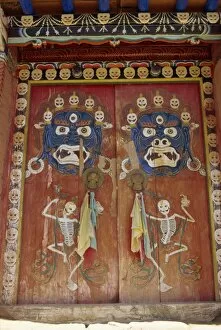Tantric Collection (#2)
"Exploring the Mystical World of Tantric Art: A Journey through Ancient Cultures" Embark on a captivating journey into the realm art
For sale as Licensed Images
Choose your image, Select your licence and Download the media
"Exploring the Mystical World of Tantric Art: A Journey through Ancient Cultures" Embark on a captivating journey into the realm art, where spirituality and sensuality intertwine in mesmerizing murals and sculptures. In Ganden, Tibet, China, Asia, a vibrant tantric mural adorns the walls of a temple, depicting intricate symbols and divine beings that evoke profound spiritual experiences. One such deity is Acala with Consort Vishvavajri, an enigmatic creation from the 16th century whose origins remain unknown. This powerful couple embodies both destruction and protection as they guard against negative forces in Buddhist tantra. Traveling to Egypt's Temple of Hathor at Dendera (Tantyris), we encounter another facet artistry. Here lies evidence of ancient Egyptian beliefs intertwined with tantric practices. The temple's exquisite carvings depict goddesses engaged in sacred rituals that celebrate life's cyclical nature. Delving further into Buddhist tantra, we encounter Hevajra - an 18th-century deity who personifies enlightened wisdom amidst chaos. His golden form exudes power as he embraces his consort Nairatmya in a ritualistic yab-yum embrace symbolizing union between masculine and feminine energies. The iconography continues to astound as we discover Chinnamasta - the Mahavidya arising from the joined bodies of the Originating Couple - depicted in Kangra during the 19th century. This gouache painting captures her fierce energy as she holds her own severed head while surrounded by flames. Vajrayogini emerges next; an enlightened being holding a skull cup from the 18th century showcases her ethereal beauty combined with ferocious determination to transcend worldly attachments. Intriguingly, even Mother-Goddess Brahmani appears seated in yogic posture while holding a water pot dating back to the 13th century.




